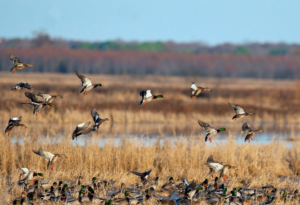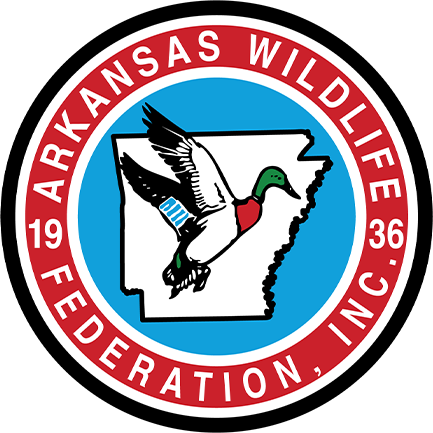Mailing Address:
P.O. Box 1500
Farmington, AR 72730
2023 Farm Bill
2023 Farm Bill
90% of land in Arkansas is in private ownership. This means that the future of wildlife is, to a great extent, in private hands. The Farm Bill offers the single largest source of funding for conservation programs benefiting wildlife on private lands.
 The Farm Bill is a large package of legislation passed by Congress every five years that sets national policy on agriculture, nutrition, forestry, and conservation – including voluntary programs that benefit wildlife.
The Farm Bill is a large package of legislation passed by Congress every five years that sets national policy on agriculture, nutrition, forestry, and conservation – including voluntary programs that benefit wildlife.
Farm Bill conservation programs provide solutions to farmers and ranchers through technical advice, cost sharing, and payments to reduce the environmental impacts of agriculture.
The last Farm Bill, The Agricultural Improvement Act of 2018, was heralded as a “wildlife-friendly Farm Bill” and a victory for conservation – thanks to years of hard work and many months of negotiations, including leadership from the National Wildlife Federation of which the Arkansas Wildlife Federation (AWF) is the state affiliate.
The 2018 Farm Bill was considered a conservation success because it included no cuts in conservation funding, increased funding toward wildlife-friendly practices, prioritized funding to combat invasive species (like feral swine) and wildlife disease (like chronic wasting disease) and included none of the attacks on our bedrock environmental laws such as the Clean Water Act and the Endangered Species Act – and more.
But these wildlife wins don’t happen on their own.
2023 – Farm Bill Up for Renewal
The Farm Bill is renewed by Congress every five years. The next renewal is 2023. Conservation groups, including AWF, have already been working hard to ensure that the conservation programs outlined in the Farm Bill remain strong, are adequately funded, and that challenges to bedrock environmental laws are defeated.
Specifically, AWF joins with the National Wildlife Federation in asking Sen. John Boozman of Arkansas who serves as the Ranking Member of the U.S. Senate Committee on Agriculture, Nutrition, and Forestry, as well as other members of Congress to:
- Double the baseline funding for Farm Bill conservation programs. (There is much more demand from producers for these programs than current funding levels can address.)
- Prevent further loss of native grasslands and prairies by making the Sodsaver provision apply nationwide. (Active now in six states, this provision reduces federal insurance premium subsidies by 50 percentage points on newly converted grasslands for four years. It does not prevent producers from converting their land, it merely asks that producers not transfer their risk to the American taxpayer when converting marginal agricultural land that serves as important wildlife habitat.)
- Increase funding and eliminate barriers for water quality and quantity conservation. (Excessive bureaucracy and lack of adequate funding restricts implementation of key programs like the Regional Conservation Partnership Program (RCCP) which is particularly effective in addressing wetland and water resource concerns.)
- Improve equity in the delivery of conservation program funding and technical assistance. (While progress has been made on equity of USDA programs in general, there continues to be need for improvement to ensure that all producers, regardless of race, gender, or farm size have access to agriculture conservation tools.)
- Better align crop insurance with conservation practices. (Congress needs to ensure that proper data is being collected by the USDA related to the impacts of conservation agriculture practices that are risk-reducing, climate-friendly, crop-appropriate, regionally flexible, and that enhance crop yields, soil health, and farm profitability – and align crop insurance discount incentives accordingly.)
- Maintain linkage between conservation compliance and crop insurance premium subsidies. (Conservation compliance provisions prevent millions of acres of wetland from being drained, and countless acres of highly erodible soils from being farmed without adequate conservation measures. Monitoring, enforcement, reporting and adequate conservation technical assistance funding, however, needs to be increased to improve quality and accuracy of these efforts.)
- Improve wildlife, climate, and agricultural outcomes for existing conservation programs. (Increasing funding and acreage caps for certain programs, optimizing carbon sequestration efforts, and publicizing more information on conservation practices that are regionally best suited to climate adaptation and mitigation is essential to providing producers with the best available tools, science, and technical assistance.)
- Address PFAS, an ongoing threat to agricultural land, wildlife, and human health. (PFAS are a class of harmful “forever” chemicals widespread in the environment. In the absence of support, producers are disincentivized from testing their soil, products, and drinking wells for contamination. Congress and the USDA need to find solutions to track and contain this problem for public health and the viability of farming operations.)
Click here to download a more detailed position statement from the National Wildlife Federation (NWF), Arkansas Wildlife Federation (AWF) and other national affiliates.
Click here to read a joint letter sent by AWF and six partner organizations to our Arkansas congressional leaders.
What Can You Do?
SPEAK UP FOR WILDLIFE AND OUR ENVIRONMENT.
Contact your members of Congress and ask them to support the points outlined in AWF’s Farm Bill Position Statement, or simply tell them to ensure conservation programs in the Farm Bill are enhanced and fully funded.
Find your Arkansas elected officials here.
